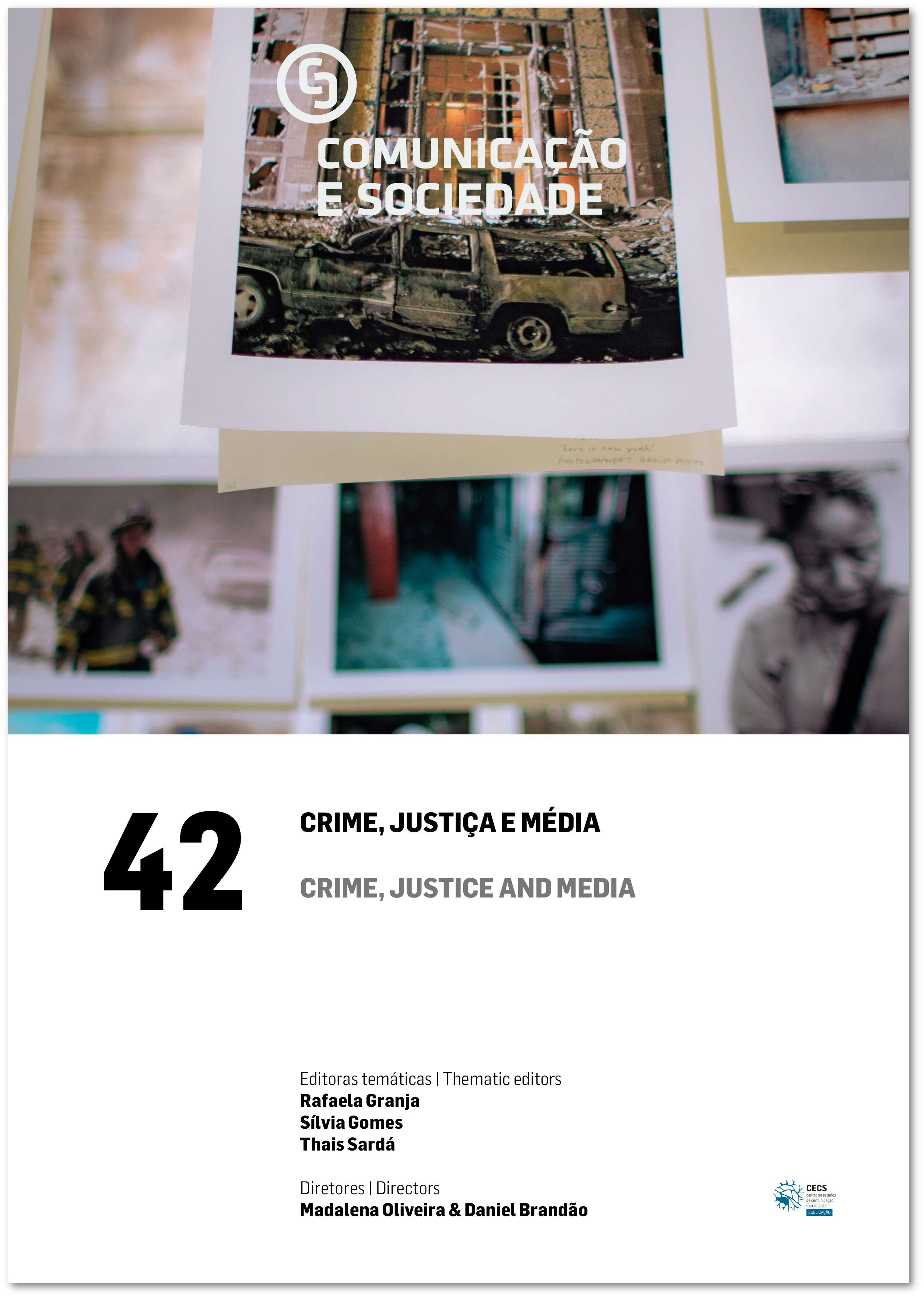Political Appearances of Extra Actors Subjects in Photojournalistic Images of Massacres in Two Favelas of Rio de Janeiro
DOI:
https://doi.org/10.17231/comsoc.42(2022).4011Keywords:
photojournalism, extra actors, political appearance, police action, Brazilian favelasAbstract
Based on theoretical-critical arguments from the field of communication and aesthetic experience, this text analyzes a set of journalistic photographs about two police operations in Rio de Janeiro, one at Complexo da Maré in 2014 and the other at Jacarezinho in 2021. In all the images, we noted that the residents appear as extras in the field of action of security agents in operations generally mediatized. The analysis exercise observed that apparitions of the extra end up destabilizing the biopolitical frameworks of photojournalism, which try to prevent the perception and apprehension of subjects and ways of life disregarded by hierarchical and asymmetric recognition conditions. Thus, we reflect on how the visibility conditions of the journalistic context can be altered by the presence and apparitions of ordinary people in photographic images, coming from the presence of bodies and people in their daily chores, through gestures and glances, and unpredicted reactions which, once registered, interfere in the images’ enunciative regime. Finally, the text reveals how the political and aesthetic power of the appearances in the figurations can highlight the nuances between the visible and the readable, allowing the opening of a fracture in the devices activated to read a certain situation, corporealities, and gestures in the images.
Downloads
References
Biondi, A., & Marques, A. (2015). Corpo sofredor: Tensões narrativas para uma política das imagens no fotojornalismo. Brazilian Journalism Research, 11(2), 120–141. https://bjr.sbpjor.org.br/bjr/article/view/694 DOI: https://doi.org/10.25200/BJR.v11n2.2015.694
Butler, J. (2004). Precarious life. Verso.
Butler, J. (2015). Quadros de guerra. Quando a vida é passível de luto? (S. Lamarão & A. Cunha, Trads.) Civilização Brasileira. (Trabalho original publicado em 2009)
Butler, J. (2018). Corpos em Aliança e a política das ruas (F. Siqueira, Trad.). Civilização Brasileira. (Trabalho original publicado em 2015)
Calderón, A. S. (2020). La performatividad de las imágenes. Ediciones Metales Pesados. DOI: https://doi.org/10.2307/j.ctv18dvtv9
Deleuze, G. (2007). A lógica da sensação (J. Justo, Trad.). Jorge Zahar. (Trabalho original publicado em 1981)
Deleuze, G., & Guattari, F. (2014). Kafka: Por uma literatura menor (C. Vieira, Trad.). Autêntica. (Trabalho original publicado em 1975)
Didi-Huberman, G. (2012). Quando as imagens tocam o real. Pós, 2(4), 204–219. https://periodicos.ufmg.br/index.php/revistapos/article/view/15454
Didi-Huberman, G. (2016a). Peuples en larmes, peuples en armes. Éditions de Minuit.
Didi-Huberman, G. (2016b). To render sensible. In A. Badiou (Ed.), What is a people? (pp. 65–86). Columbia University Press. DOI: https://doi.org/10.7312/badi16876-005
Didi-Huberman, G. (2020). Imagens apesar de tudo (V. Brito & J. Cachopo, Trads.). Editora 34. (Trabalho original publicado em 2004)
Hjarvard, S., & Mortensen, M. (2015). The dynamics of mediatized conflicts. Peter Lang.
Lévinas, E. (1999). Alterity and transcendence. Columbia University Press.
Marques, A. C. S., & Souza, F. C. V. (2018). À escuta do rosto nas imagens: Aproximações entre Lévinas, Butler e Didi-Huberman. In N. Ribeiro (Ed.), Amor e justiça em Lévinas 1 (pp. 99–114). Editora Perspectiva.
Mbembe, A. (2018). Necropolítica. Editora N-1.
Pelbart, P. P. (2002). Pouvoir sur la vie, puissance de la vie. Multitudes, 9, 25–35. https://www.multitudes.net/Pouvoir-sur-la-vie-puissance-de-la/ DOI: https://doi.org/10.3917/mult.009.0025
Pelbart, P. P. (2003). Vida capital: Ensaios de biopolítica. Iluminuras.
Picado, J. B. (2011). Sentido visual e vetores de imersão: Regimes plásticos da implicação do espectador nas formas visuais do fotojornalismo. Galáxia, (22), 53–66. https://revistas.pucsp.br/index.php/galaxia/article/view/6994
Picado, J. B. (2020). O fantasma da teoria: O que significa “ver-através” de fotografias? Revista de Comunicação e Linguagens, 53, 168–187. https://rcl.fcsh.unl.pt/index.php/rcl/article/download/15/15/
Rancière, J. (2003). O destino das imagens (M. Netto, Trad.). Contraponto. (Trabalho original publicado em 2012)
Rancière, J. (2008). Le spectateur émancipé. La Fabrique. DOI: https://doi.org/10.3917/lafab.ranci.2008.01
Rancière, J. (2018). Le temps modernes. La Fabrique.
Rancière, J. (2019). Le travail des images. Conversations avec Andrea Soto Calderón. Les Presses du Réel.
Ribeiro, N., Jr. (2019). Poemática imagem de um rosto: [Semio]ética da comunicação e da fotografia. In F. Vieira & A. Marques (Eds.), Imagens e alteridades (pp. 46–65). Selo PPGCOM, UFMG Editora.
Rosa, A. P. (2020). A imagem em circulação: Estilhaçando o olhar e a memória. In B. Heller, D. Cal, & A. P. da Rosa (Eds.), Midiatização (in)tolerância e reconhecimento (pp. 187–208). FACOS - UFSM.
Schaeffer, J. M. (1996). A imagem precária. Papirus.
Sontag, S. (2003). Diante da dor dos outros. Companhia das Letras.
Tagg, J. (1998). The burden of representation. University of Massachusetts Press.
Veras, P. F. (2017). Desvios de olhar: As aparições de figurantes no cinema novo [Dissertação de mestrado, Universidade Federal de Minas Gerais]. Repositório Institucional da UFMG. http://hdl.handle.net/1843/37132
Downloads
Published
How to Cite
Issue
Section
License
Copyright (c) 2022 Ângela Cristina Salgueiro Marques, Angie Biondi, Ana Paula da Rosa

This work is licensed under a Creative Commons Attribution 4.0 International License.
Authors own the copyright, providing the journal with the right of first publication. The work is licensed under a Creative Commons Attribution 4.0 International License.












